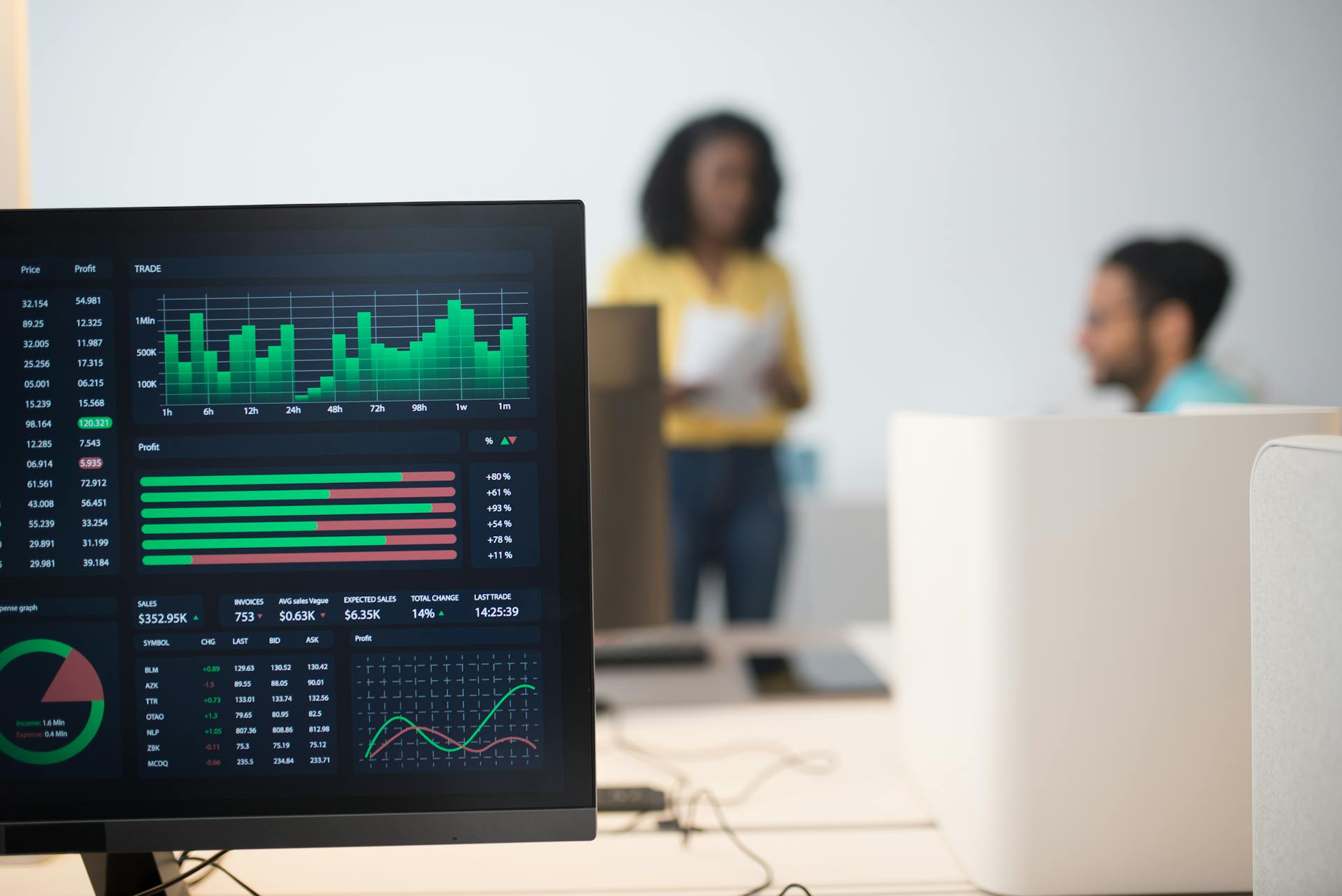
A contract for differences (CFD) can be a powerful tool for traders, but like any investment strategy, it comes with its own set of benefits and risks.
CFDs allow traders to speculate on price movements without actually owning the underlying asset, which can be beneficial for those who want to avoid the costs and complexities of ownership.
One of the key benefits of CFDs is that they offer high leverage, which means traders can control large positions with a relatively small amount of capital.
This can amplify potential gains, but it also increases the risk of significant losses if the market moves against the trader.
CFDs also offer flexibility, as traders can choose from a wide range of underlying assets, including stocks, commodities, and currencies.
This flexibility can be particularly useful for traders who want to diversify their portfolios or take advantage of market opportunities that may not be available through traditional ownership.
For another approach, see: When You Want Different for Yourself?
However, CFDs can also be subject to significant fees and charges, which can eat into the trader's profits.
These fees can include commissions, financing costs, and other expenses that can add up quickly.
As a result, traders need to carefully consider the costs and risks associated with CFDs before deciding to use them.
Intriguing read: What Are Cfds
What Is a Contract for Differences
A contract for differences, or CFD, is an agreement between two parties that stipulates the buyer must pay the seller the difference between the current value of an asset and its value at contract time.
CFDs are a type of derivatives trade that allow traders and investors to profit from price movement without owning the underlying assets.
There is no physical delivery of goods or securities in a CFD, only a cash-settled exchange of the difference between the initial price of the trade and its value when the trade is unwound.
The difference between the open and closing trade prices is cash-settled, with the client and the broker exchanging the difference.
Curious to learn more? Check out: Trade Futures Contracts
If the closing trade price is higher than the opening price, the seller will pay the buyer the difference, and that will be the buyer's profit.
A CFD gives traders an opportunity to leverage their trading by only having to put up a small margin deposit to hold a trading position.
There are no restrictions regarding the timing of the entry or exit, and no restrictions of time over the period of exchange.
Here's an interesting read: Debt Buyer (United States)
Benefits and Features
With contract for differences (CFDs), you get to trade on a level playing field. ASX, the exchange, is independent of the parties you deal with, ensuring markets are fair, orderly, and transparent.
One of the key benefits of trading CFDs is transparency. ASX reports on all CFDs transacted, open positions, bids, offers, and volumes, giving you a clear picture of the market.
You can trade CFDs on a wide range of assets, including global indices, sectors, currencies, stocks, and commodities. This variety is a major advantage over other types of instruments.
Take a look at this: Asx Share Prices
Here are some of the key features of trading CFDs:
- Market independence, ensuring fair and transparent markets
- Transparency, with ASX reporting on all CFDs transacted
- Counterparty risk reduced, with SFE Clearing Corporation guaranteeing settlement obligations
- Favorable margins, attracting many brokers worldwide
- Direct market access (DMA), allowing you to trade globally
- Ability to trade on both rising and falling asset prices
- No need to invest the full amount, only margin required
Advantages of
Trading Contracts for Difference (CFDs) offers several advantages that make it an attractive option for investors. One key benefit is market independence, which ensures that markets are fair, orderly, and transparent.
The ASX, for example, is independent of the parties with whom a customer receives advice and deals through. This separation of responsibility between broker and exchange provides customers with choice as to whom they wish to execute their business.
Transparency is another significant advantage of trading CFDs. ASX reports on all ASX CFDs transacted, open positions, bids, offers, and volumes. This level of transparency allows traders to make informed decisions.
The ASX CFD central market order book is available for the market to see, and all orders are executed on a strict price/time priority. This ensures that trades are executed fairly and efficiently.
Counterparty risk is also significantly reduced when trading CFDs through the ASX. All settlement obligations are cleared and guaranteed by SFE Clearing Corporation (SFECC), which has a statutory obligation to operate "fair and efficient" facilities.
Here are the top advantages of trading CFDs:
- Market independence
- Transparency
- Reduced counterparty risk
Equity Based Trade
You can buy and sell CFDs on shares, which is known as an equity based trade. This type of trade involves buying a CFD at the offer price and selling it at the bid price.
The margin requirement for an equity based trade is typically between 3-15% of the trade value, depending on the liquidity of the underlying instrument. For example, if you buy 100 Apple CFDs at $194.42, the margin requirement might be 5% of the trade value.
You'll also be charged commission on each trade, which is usually a percentage of the trade value. For instance, buying 100 Apple CFDs at $194.42 might incur a commission of $19.44.
Overnight financing charges are also applicable, which are normally based on a benchmark rate per cent like LIBOR plus the broker's margin per cent divided by 365. For example, holding a position in Apple CFDs for a day might incur an overnight financing charge of $1.20.
Discover more: Investors Buy Stock at the

Here's a breakdown of the costs associated with an equity based trade:
This means that even if you make a profit on your trade, you'll still need to factor in these costs to determine your net profit. For example, if you made a gross profit of $608, your net profit would be $608 - $40.69 = $567.31.
Trading and Risks
Trading with CFDs can be a high-risk, high-reward game. A trader's potential loss can be substantial, especially if they're not prepared for market volatility. Initial margin requirements can range from 0.5% to 30% depending on the underlying product and perceived risk.
The initial margin is essentially a deposit, which can be as low as 3% for large and liquid stocks. However, this can increase to 10% or more for smaller capitalized and less liquid stocks.
Variation margin, on the other hand, is applied in real-time as the market moves, and can have either a negative or positive effect on a CFD trader's cash balance. If the market moves against a trader, they may face a margin call, which can lead to significant losses.
Here are some key margin requirements to keep in mind:
It's essential to understand that CFDs are leveraged investment products, which means that even a small price movement can result in significant gains or losses.
How They Work
A CFD is an agreement between an investor and a CFD broker to exchange the difference in the value of a financial product between the time the contract opens and closes.
You don't actually own the underlying asset in a CFD transaction, but you're paid based on the price change of that asset.
Traders can use CFDs to make bets about whether or not the price of the underlying asset or security will rise or fall.
They can bet on either upward or downward movements, and if the trader sees the asset's price increase, they'll offer their holding for sale.
The net difference between the purchase price and the sale price is determined, and the net difference representing the gain from the trades is settled through the investor's brokerage account.
You can buy or sell a CFD, and if you buy, you're taking a long position, and if you sell, you're taking a short position.
Take a look at this: S B I Card Share Price
The first trade creates the open position, which is later closed out through a reverse trade with the CFD provider at a different price.
To close a long position, you need to sell the CFD, and to close a short position, you need to buy the CFD.
The net profit of the trader is the price difference between the opening trade and the closing-out trade, less any commission or interest.
You don't need to deposit the full value of a security to open a position, only a portion of it, known as "margin".
This makes CFDs a leveraged investment product, amplifying the effects of price changes in the underlying security for investors.
The margin is what makes CFDs so powerful, but it also means that losses can be just as amplified as gains.
Additional reading: Security Contracts
No Day Requirements
The CFD market is a great option for those who want to day trade without any restrictions.
All account holders can day trade if they wish, which is a big advantage over other markets that may have limitations.
Recommended read: Wash Trade Rule
You can often open an account for as little as $1,000, making it more accessible to traders of all levels.
However, $2,000 and $5,000 are common minimum deposit requirements, so be prepared for that.
This flexibility is one of the reasons why the CFD market is so popular among traders.
No Shorting or Borrowing
In some markets, there are specific rules that govern shorting, requiring traders to borrow the instrument before selling short or imposing different margin requirements for short and long positions.
Certain markets have rules that prohibit shorting altogether.
CFD instruments can be shorted at any time without borrowing costs because the trader doesn’t own the underlying asset.
Margin
Margin is a crucial concept in trading CFDs, and understanding it is essential to managing your risk. Initial margin is typically between 3% and 30% for shares/stocks and 0.5% - 1% for indices, foreign exchange, and commodities.
The initial margin can be thought of as a deposit, and it's used to cover the potential losses of a trade. For example, if you're trading a large and highly liquid stock like Vodafone, the initial margin might be as low as 3%. However, with smaller, less liquid stocks, the margin can be significantly higher.
Recommended read: Libor Rate Usd 3 Months
Variation margin is applied to positions if they move against you. This means that if the price of the asset you're trading moves lower, the broker will deduct the loss from your account. Conversely, if the price moves higher, you'll receive the profit.
CFDs allow you to go short or long on any position using margin. This means that you can control a larger position with a smaller amount of capital, amplifying your potential for profit or loss. However, this also means that you're exposed to a margin call in a downturn, which can result in losing a substantial part of your assets.
Here's a summary of the two types of margin:
The margin requirements on CFDs are low, meaning that only a small amount of money is required to take large positions. However, this also means that increased leverage can magnify a trader's losses.
Stop Loss Orders
Stop loss orders are a crucial tool for traders to limit potential losses, but they can be tricky to execute, especially on low-liquidity stocks.
A stop loss order can be set to trigger an exit point as pre-determined by the trader, such as buying at $3.00 with a stop loss at $2.60. This order is then activated to the CFD provider, who will action it according to their terms of business and available liquidity.
If the stop loss price is triggered, the order may not be executed if the price rapidly moves outside a limited price range, or if there's insufficient liquidity for the order. This is particularly problematic on stocks with low liquidity.
Market makers have the ability to manage the stop loss and close the position wherever they see matching price and quantity are available, increasing the chances of getting out of a losing position. However, this may not always result in the best price.
The price of a stop loss order is only a target price, and it depends on whether the market price actually trades at that level. If the underlying instrument price 'gaps', the stop will get executed at the next price that was traded or not at all, depending on the CFD provider.
To mitigate this problem, some providers offer 'Guaranteed Stop Loss Orders' (GSLO), which come with an additional charge and restrictions, such as a minimum distance of 5% from the current price.
Suggestion: Equity Market Liquidity
Disadvantages
Trading and risks go hand in hand, and it's essential to be aware of the potential downsides of trading CFDs.
Higher costs are a significant disadvantage of trading CFDs. The exchange, clearing house, and broker all charge fees, which can eat into your profits. Administration costs are also higher due to exchange and clearing requirements.
Limited product offerings are another drawback of trading CFDs on the Australian Securities Exchange (ASX). They only offer a small number of CFDs, which is a far cry from the thousands of underlying products available through over-the-counter (OTC) providers.
Pricing can also be a concern when trading ASX CFDs. The prices and spreads are based on CFD orders only, which can result in prices and spreads that differ from those of the underlying instrument.
Here are some of the key disadvantages of trading CFDs on the ASX:
Counterparty risk is another significant risk associated with trading CFDs. If the counterparty to a contract fails to meet their financial obligations, the CFD may have little or no value, regardless of the underlying instrument's performance.
Traders Pay the Spread
The spread is a cost associated with trading Contracts for Differences (CFDs). It's a fee that traders pay on every entry and exit, and it can eliminate the potential to profit from small price movements.
In Example 2, we see that the spread decreases winning trades by a small amount compared to the underlying security. This means that even if a trader makes a profit, the spread will reduce the amount of that profit.
The spread also increases losses by a small amount. This can be seen in Example 2, where the spread is mentioned as a cost that increases losses.
Here's a breakdown of the costs associated with trading CFDs:
These costs can add up quickly, and traders need to be aware of them to make informed decisions.
Central Clearing Attempt
In October 2013, a significant attempt at central clearing was made by LCH.Clearnet, in partnership with Cantor Fitzgerald, ING Bank, and Commerzbank.
They launched centrally cleared CFDs, which is a major step towards reducing counterparty risk in the market.
This move was in line with the EU financial regulators' aim of increasing the proportion of cleared OTC contracts.
Bucket Shops
Bucket shops were a type of operation that flourished in the United States at the turn of the 20th century.
These establishments allowed speculators to place highly leveraged bets on stocks, often without the backing or hedging of actual trades on an exchange.
Bucket shops were effectively betting against the house, making it a high-risk and potentially lucrative venture for those involved.
Their practices were colourfully described in Jesse Livermore's semi-autobiographical "Reminiscences of a Stock Operator".
In the United States, bucket shops are now illegal according to both criminal and securities law.
For another approach, see: What Makes up a Ticker Symbol in the United States
Futures
Futures are a type of derivatives trading that involves an agreement to buy or sell an underlying asset at a set price at a set date in the future.
Professionals prefer futures contracts for indices and interest rate trading over CFDs because they are a mature product and are exchange traded.
Futures contracts tend to see price decay near to the expiry date compared to the price of the underlying instrument, which doesn't occur with CFDs.
CFDs, on the other hand, never expire and simply mirror the underlying instrument, making pricing more transparent.
Futures are often used by CFD providers to hedge their own positions and many CFDs are written over futures as futures prices are easily obtainable.
The industry practice is for CFD providers to 'roll' the CFD position to the next future period when the liquidity starts to dry in the last few days before expiry, creating a rolling CFD contract.
Difference from FTR
CFDs differ from FTR in two key ways. One of these differences is that CFDs are defined at a specific location, rather than between two locations.
This means that CFDs are primarily used to hedge against price risk at a particular location, rather than between locations.
CFDs are not traded through regional transmission organizations (RTOs) markets, unlike other financial instruments.
Instead, CFDs are typically used in bilateral contracts between individual market participants.
Trading Countries
You can trade CFDs in many countries, including the UK, Australia, Germany, Switzerland, Singapore, Spain, France, South Africa, Canada, New Zealand, Sweden, Norway, Italy, Thailand, Belgium, Denmark, and the Netherlands, as well as the Hong Kong special administrative region.
The U.S. Securities and Exchange Commission has restricted the trading of CFDs in the United States, but nonresidents can trade using them.
CFD trading is allowed in over 20 countries worldwide, making it a relatively accessible trading strategy.
The decline in equities markets in 2022 led to a decrease in investor interest in CFD trading, as reflected in lower Google search activity related to CFDs.
Trading revenue from brokerage firms that offer CFD trading also declined during this period.
Long vs Short
Long vs Short is a fundamental concept in trading that can be a bit confusing, especially for beginners. A long position is essentially buying an asset in anticipation of its price increasing.
Going long means you're hoping the underlying asset price will rise. For example, if you expect oil prices to increase, you'd trade on the long side.
The key difference between long and short is the direction of the price movement you're anticipating. If you think the price will go up, you go long; if you think it will go down, you go short.
See what others are reading: Asset Trading
Going short, on the other hand, means selling a contract for difference based on anticipating a price decrease in the underlying asset. This allows you to profit from a falling market.
CFDs make it possible to short an asset without borrowing the underlying asset, which can save you money on borrowing costs.
Consider reading: Contract for Borrowing Money
Understanding Losses and Gains
A CFD trade can result in significant losses if the market moves against you. For example, if the share price of GlaxoSmithKline drops by 6.15, a trader who bought CFDs at £23.50 per share would incur a loss of £1,549.50 (426 contracts x £3.30).
The initial margin requirement for a CFD trade can be as low as 3% for large and highly liquid stocks like Vodafone, but can be as high as 30% for smaller and less liquid stocks. Initial margin is a deposit that is deducted from your account when you open a position.
Intriguing read: 30 Day Libor Rate
Leverage is a key feature of CFD trading, allowing you to control a larger position with a smaller amount of capital. However, this also means that your potential losses can be amplified if the market moves against you.
Here are some examples of potential losses and gains in CFD trading:
Remember, CFD trading involves significant risks, and it's essential to understand these risks before entering into a trade. Always set a stop-loss order to limit your potential losses and never invest more than you can afford to lose.
Frequently Asked Questions
Why are CFDs banned in the US?
CFDs are banned in the US due to concerns over lack of transparency and risks associated with leveraged trading. This is because CFDs are traded directly between parties, bypassing regulated exchanges.
What is one difference between a contract for difference CFD and a futures contract?
A key difference between CFDs and futures contracts is that CFDs are not actual contracts to buy or sell an asset, but rather a way to trade on price movements. This distinction affects how CFDs and futures contracts are used and regulated in the financial markets.
Sources
- https://trader.fandom.com/wiki/Contract_for_difference
- https://www.investopedia.com/articles/stocks/09/trade-a-cfd.asp
- https://en.wikipedia.org/wiki/Contract_for_difference
- https://www.gov.uk/government/collections/contracts-for-difference
- https://corporatefinanceinstitute.com/resources/derivatives/contract-for-difference-cfd/
Featured Images: pexels.com


